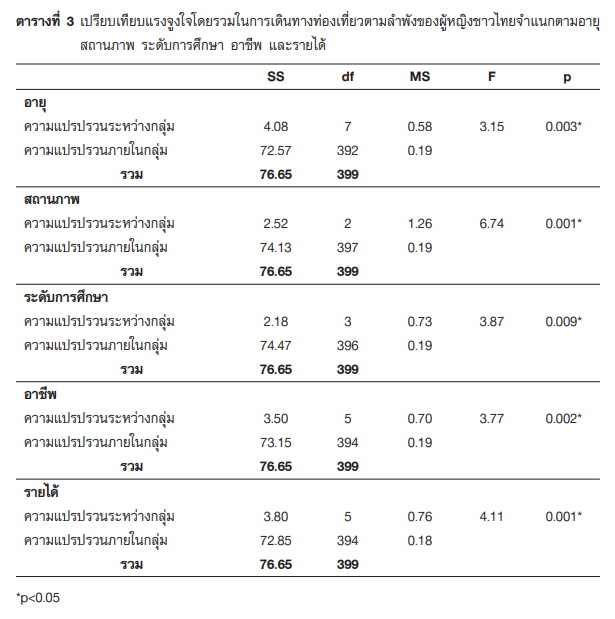THE MOTIVE TO TRAVEL SOLO OF THAI FEMALES
Main Article Content
Abstract
Purpose The purpose of this research was to study the motive to travel solo of Thai females and compare their demographic attributes: age, status, education level, career and income.
Methods The method in quantitative research was a survey. The samples of research consist of 400 Thai females are 20 years old who had experienced or interested in solo travel overseas and had planned to solo travel included business traveling, but except a travelling for further education. This research used questionnaires as the main method to collect data with IOC of 0.89 and coefficient alpha equal 0.90. This study also applied statistical data analyses using the determination of patterns in the data such as the frequency, percentage, mean and standard deviation. The research also undertook One-Way ANOVA. Thereafter, if the research revealed the difference of statistical significance at 0.05, LSD technique was adopted to test the pair differences.
Results The hypotheses testing revealed that overall motive to travel solo of Thai females reached the high level of agreement (x = 4.00). The highest motives categorized by items were Physical motive (x = 4.42) followed by the high motives of Self-development (x = 4.18), Culture (x = 4.02), Emotion (x = 3.99), Status and Prestige (x = 3.78) and Person (x = 3.64) respectively. The comparison of demographic attributes revealed that Thai females who have different age, status, education level, career and income had different motives to travel solo with statistical significance at 0.05
Conclusion Thai females have motives to travel solo at the high level of agreement and physical motive is highest while others are high. Moreover, the demographic attributes: age, status, education level, career and income have different motives to solo traveling.
Article Details
References
Akaranggoon, S. (2009). Tourists’ Behavior. Khonkaen: Klangnanawittaya.
Bakan, D. (1966). The Duality of Human Existence. Chicago: Rand McNally.
Buhalis, D. (2000). Marketing the Competitive Destination of the Future. Tourism Management, 21,97-116.
Charmuangkul, P. (2014). Thai Tourists’ Opinions of Traveling to Oversea by unused Travel Agency. Master’s Thesis, Faculty of Sports Science, Chulalongkorn University. Bangkok.
Digital Economy Promotion Agency. (2016). Digital Tourism for SME’s. (online). Retrieved January, 2018, from https://www.depa.or.th/en/article/sme-digitaltourismforsme/
Jang, S., And Cai, L. (2002). Travel motivationsand destination choice: A study of Britishoutbound market. Travel and TourismMarketing, 13(3), 111-133.
Jaturongkakul, A. (2000). Consumer Behavior. Bangkok: Thammasat University.
Kanjanakij, S. (2014). Recreation and Tourism. Bangkok: Chulalongkorn University.
Mahasaranon, R. (2003). Tourists’ Need Analysis. Bangkok: Dhonburi Rajabhat University.
Matsangou, E. (2018). The Rising Popularity of Solo Travel. (Online). Retrieved September 29, 2018, from: https://www.businessdestinations.com/featured/the-risingpopularity-of-solo-travel-and-the-womenenefitting-from-the-trend/
Obenour, W. L. (2005). The Journeys of Independence for Female Backpackers. Tourism Review International, 9(2), 213-227.
Parasakul, L. (2012). Tourist’s Behavior. Bangkok: Chulalongkorn University. Pongpanarat, K. (2017). Development Situations and Travel Trends of World, Asian, and Thai.(online). Retrieved June 20, 2018, from https://www.citu.tu.ac.th>public>upload>pdf
Poomjamnean, K. (2012). Impact Factors of Tourists in Bangkok Metropolitan Region Self-travel to Oversea. Bangkok: Thammasat University Research and Consultancy Institute.
Prasertsri, R. (2005). Organizations’ Behavior. Bangkok: Thammasarn.
Sereerat, S. (2007). Consumer Behavior. Bangkok: Theera Film and Cytex
Swarbrooke, J., and Horner, S. (2007). Consumer Behavior in Tourism (2nd ed.). Oxford: Butterworth Heinemann.
Tantivanij, V. (2003). Principles of Marketing. Bangkok: Pearson Education Indo-China.
Tourism Authority of Thailand. (2014). Behavior Trend in 2014. (online). Retrieved May 24, 2018, from: https://www.etatjournal.com/web/menu-read-web-etatjournal/menu-2014/menu-2014-0ct-dec/619-42557-trend-2014
Tourism Authority of Thailand. (2016). TAT review 2(4) October-December 2559. (online). Retrieved June 29, 2018: https://www.etatjournal.files.wordpress.com/2016/10/tat420161.pdf/
Wannathanom, C. (2009). Planning and Tour Management. Bangkok: Samlada.
Yamane, T. (1973). Statistics: An Introductory Analysis. (3rd ed.). New York: Harper and Row.
Yang, E.L., Khoo L.C., and Arcodia, C. (2018). Power and empowerment: How Asian solo female travelers perceive and negotiate risks. Journal of Tourism Management, 68, 32-45.


